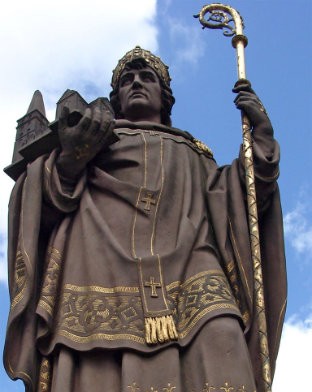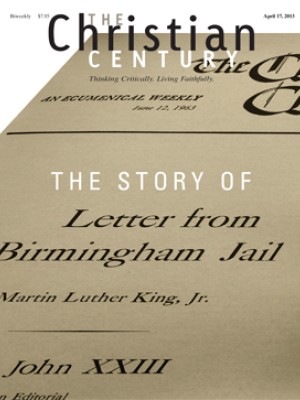Discovering the saints: A church meets a cloud of witnesses

In the underrated film drama Into Temptation, a priest preaches to the small, stoic congregation of St. Mary Magdalene on the feast day of a St. Cyril, who lived a life of complete chastity, poverty and sobriety. “It’s no wonder the Irish didn’t adopt him,” Father John jokes. He goes on to mention some of the more obscure saints he’s drawn to. Has anyone heard of St. Hubert the Silent or St. Richard the Whoremonger? “I’m not making this up,” the priest tells his congregants, to the proverbial sound of crickets chirping.
It’s a familiar enough scene to any preacher who has tried to bring the living witness of the ancient faithful into the historically amnesiac present. So I hesitated when Dawn Mass, my senior colleague, suggested that we devote a ten-week sermon series to some of the prominent saints of church history. My seminary education gave me great love for the patristic and medieval theological worlds, but my pastoral experience has left me wary of trying to make Athanasius’s prickliness come alive in a sermon. Would anyone find this interesting? Would it feel like a history lesson?
Read our latest issue or browse back issues.
Yet it was hard to resist. It is often said that Protestants have an “ecclesial deficit,” and this is never more evident than in times of actual or potential schism. For us Lutherans, there is no way to supplement that deficit without embracing our catholic and international heritage beyond and between Paul, Augustine, Luther and modern-day North America. My congregation’s tendency—and not its alone, to be sure—has been to confine itself to what Paul Tillich called the “leaping theory of Protestantism,” and this needed some filling in.
So we decided to do it. We called the series “This Is My Church.” Along with presenting video portraits of our ministries, we would strive to introduce our congregation (and in some instances ourselves) to the voices who helped make the church we claim as ours.
We set three limits on the series. First, we would stay on the lectionary (to the relief of our music director, who likes to program music thematically in advance). We would be bound by the words and emphases of the readings for every Sunday. Second, we would go in chronological order. Third, we would maintain a reasonable balance between men and women. A fourth went unstated: we would not bore our people with our own historical enthusiasm.
These constraints pushed us deeply into the calendars of commemoration and the lives of the saints. (Philip Pfatteicher’s Festivals and Commemorations, Sam Portaro’s Brightest and Best and Butler’s Lives of the Saints were invaluable, supplemented by individual volumes on people and periods.) As a result, we stretched ourselves and our congregation.
On Reformation Sunday we eschewed Luther and Melanchthon in favor of 16th-century Roman Catholic reformer Bartolomé de las Casas, whose antislavery activism in the New World echoed Jesus’ pronouncement, “if the Son sets you free, you are free indeed.” All Saints Day is so rarely ancient or international in emphasis when we observe it. But my colleague came to love 17th-century German missionary Bartholomäus Ziegenbalg, whose willingness to learn a new language and live outside the European settlement in Tranquebar, India, helped us envision the vast multitude from every nation in the day’s reading from Revelation.
Over the weeks of learning and preaching, these distant lives began to feel very contemporary. Perpetua and Felicity, the third-century North African martyrs, defied a death-loving culture. Ninth-century missionary Ansgar strove to bring the gospel to an indifferent or hostile Scandinavia, while doing works of mercy that overcame his many disappointments and setbacks.
The radical servanthood of Elizabeth, a 13th-century Hungarian princess who lived most of her short life in Germany, reflected ironically on contemporary princess culture, just as her mistreatment at the hands of an overbearing spiritual director reflected on the enduring vulnerability of the pious to religious abuse. The apostle Paul broke down worldly barriers. Dietrich Bonhoeffer, obscure in his own lifetime, amplified his personal heroism by trying to make Christian sense of a world that no longer needed God.
As we gained companions in the defeats, perplexities, dilemmas and abiding faith that characterize the church in every age, a sense of preacherly fellowship developed between past and present. It didn’t hurt that their words were, unsurprisingly, more eloquent than our own.
The incarcerated Perpetua recounts her pagan father’s pleading with her to recant her faith. She asks him, “Do you see—for example—this vessel lying here as a little pitcher or as something else?”
“I see it as a little pitcher,” he replies.
“Can it be called by any other name than what it is?” she asks. He says no. “Nor can I call myself anything else than what I am,” she concludes, “a Christian.”
As for Ansgar, claims of miraculous healings were made on his behalf. “Were I worthy of such favor from my God,” he responds, perhaps skeptically, “I would ask that he would grant me this one miracle, that by his grace he would make of me a good man.”
Søren Kierkegaard, lamenting the dearth of hope in the 19th-century Danish church, proclaims that “he who always hopes for the best grows old, deceived by life, and he who is always prepared for the worst grows old too soon, but he who has faith preserves an eternal youth.” I compared Kierkegaard’s view of the church to a race in which everyone has agreed to stop running before the finish line. Everyone in church was asked to grasp the hand of someone nearby and to exhort each other to “keep running.”
Pastor Dawn ended the series with a sermon on Leymah Gbowee, the Liberian activist who shared the 2011 Nobel Peace Prize with two other women who worked fearlessly to end that country’s devastating civil war. She quoted Gbowee’s message to the 2012 ELCA National Youth Gathering, at which 30 of our own youth were present: “The world has heard from King; the world has heard from Mandela; the world has heard from Gbowee.” Dawn went on: “We could add, the world has heard from de las Casas; the world has heard from Ziegenbalg; the world has heard from Kierkegaard; the world has heard from Bonhoeffer. Now the world needs to hear from you.”
Most gratifying was the congregation’s response. They were genuinely excited to have these small parts of their past restored to them. I’ve long been fascinated by people like Kierkegaard and Bonhoeffer, so I should not have been surprised to hear requests for adult education series on them, for more of the insight these lives offer to our own questions and more of the inspiration they give to our own humble efforts to bear witness to Christ and participate in the healing of the world.
We illustrated the series with a map of the world that became populated, week by week, with images of these saints and ribbon (red for the martyrs, gold for the rest) marking their itineraries. This was yet another fancy with an unclear meaning. But I soon learned it had an impact.
At church, messages are occasionally relayed by our “Snow Chuckie”—a kitschy, candy-cane-wielding snowman figurine that looks sinister when a note demanding an overdue annual report is speared on his carrot nose. One evening I was greeted by Chuckie, bearing a different sort of note. “Pastor Ben—where’s Ansgar?” the little monster was demanding. Ansgar, the not very successful missionary to Scandinavia, founder of Bremen’s first hospital and collector of devotional prayers for each psalm, was recently as unknown in our parish as St. Richard the Whoremonger was in Into Temptation. He had fallen off the map. Someone had noticed.
I promptly printed off a new image of St. Ansgar holding a small church (his Bremen cathedral, I imagine) and his dates. I returned him to the cloud of witnesses that had watched over, preached with and encouraged us all along.






